CD – 3 tracks – 50m 11s
6-panel digipak
Photography by Jon Wozencroft
Track listing:
1. Aquaculture 18:00
2. Isolation/Measurement 12:11
3. Sense of Latent Power 20:04
Armed with four 8011 DPA hydrophones, DPA 4060 omni mics, a Telinga parabolic reflector mic and a Sound Devices 744T digital hard disk recorder, Jana Winderen studies and records wild places which have a particular importance in our understanding of the complexity and fragility of marine ecosystems.
The recordings were made on field trips to the Barents Sea (north of Norway and Russia), Greenland and Norway, deep in crevasses of glaciers, in fjords and in the open ocean. These elements are then edited and layered into a powerful descriptive soundscape. The open spaces of Greenland, northern winds, ravens and dogs in an icy landscape provide the setting for these haunting but dynamic pieces. Sounds of crustaceans, fish such as cod, haddock, herring and pollock recorded as they are hunting, calling for a mate or orientating themselves in their environment, are all included in the mix. The result is a powerful, mesmeric journey into the unseen audio world of the frozen north.
Artist statement:
“I like the immateriality of a sound work and the openness it can have for both associative and direct experience and sensory perception. I have been occupied with finding sounds from unseen sources of sound, like blind field recordings. Over the last four years I have collected recordings made by hydrophones, from rivers, shores and the ocean, and more recently also from glaciers in Greenland, Iceland and Norway. In the depths of the oceans there are invisible but audible soundscapes, about which we are largely ignorant, even if the oceans cover 70% of our planet. I am also experimenting with different types of microphones to collect sounds which are not obviously recognisable, but give room for broader, more imaginative readings. I use these sounds as source material for composition in a live environment or to create installations, currently also for film, radio, CD and vinyl productions.”
Artist biography:
Jana Winderen is an artist educated in Fine Art at Goldsmiths College in London, and with a background in mathematics, chemistry and fish ecology from the University in Oslo, Norway. She has since 1993 worked as an artist, curator and producer. She currently lives and works in Oslo, Norway. Her most recent sound works include “Evaporation” (2009) at TodaysArt festival in The Hague, Netherlands, “Sub Pelagic Voices”(2009) for ISCM World New Music Days, Sweden, “Colonisers of the undergrowth” at Botanic Sounds in Göteborg Botanic Gardens; “North Atlantic Drift” (2009) for JunKroom in Kyoto, Japan, based on hydrophone recordings in the Barents Sea; “freq_out 7” curated by CM von Hausswollf at the Happy New Ears festival in Belgium (2008); “Submerge” (2008) for Färgfabriken Norr, Sweden and the 6 channel sound installation “+4°C – from Folgefonna to the North Sea” (2007) at Sleppet during the centenary Greig07 in Norway.
She recently released the CD “Heated: Live in Japan” (2009) on Touch (UK), the audio cassette “The Noisiest Guys on the Planet”(2009) on Ash International (UK), the USB stick, “Ants”, the digital download “Submerged” (2009) on Touch and the 7 inch vinyl “Surface Runoff” (2008) on Autofact (USA). Future projects includes an audio commission for the AV festival and the Environmental Agency in Newcastle (UK) working with the river Coquet in Northumberland, the audio piece “The Land Between” for ‘The Morning Line’, Thyssen-Bornemisza Art Contemporary, Istanbul 2010. Jana also works on a collaborating with ‘Mobile Homes’ for the performance ‘Passing Place’ in Norway and she is currently working on a commission for a permanent sound installation at the Knut Hamsun Centre in Hamarøy, Norway. Recently Jana’s underwater recording was played on BBC Radio 3’s “Late Junction”, and BBC Radio 4 followed Jana on her recording trip in the Barents Sea for the radio series “World on the Move”. Jana has exhibited and performed her work in Canada, Japan, USA, Spain, China, Thailand, France, Hungary, Italy, Denmark, England, Germany, Netherlands, Norway, Belgium and Sweden.
Reviews:
The Wire (UK):
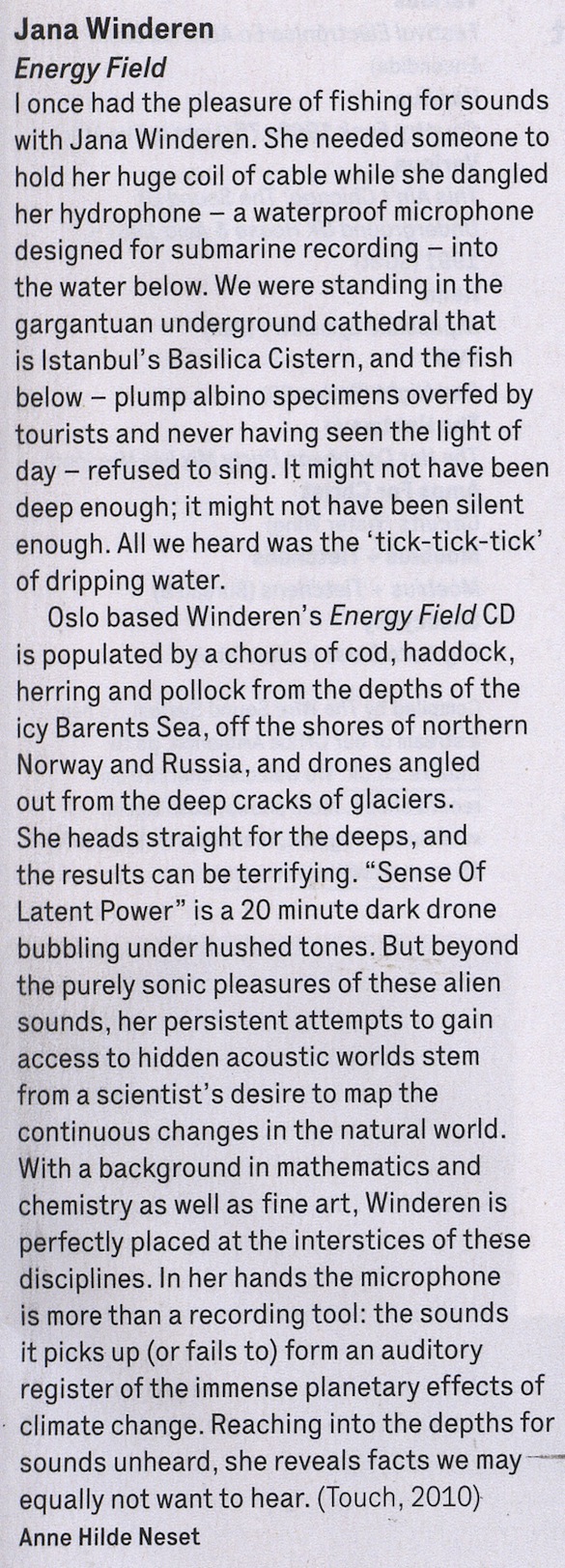
The Sound Projector (UK):
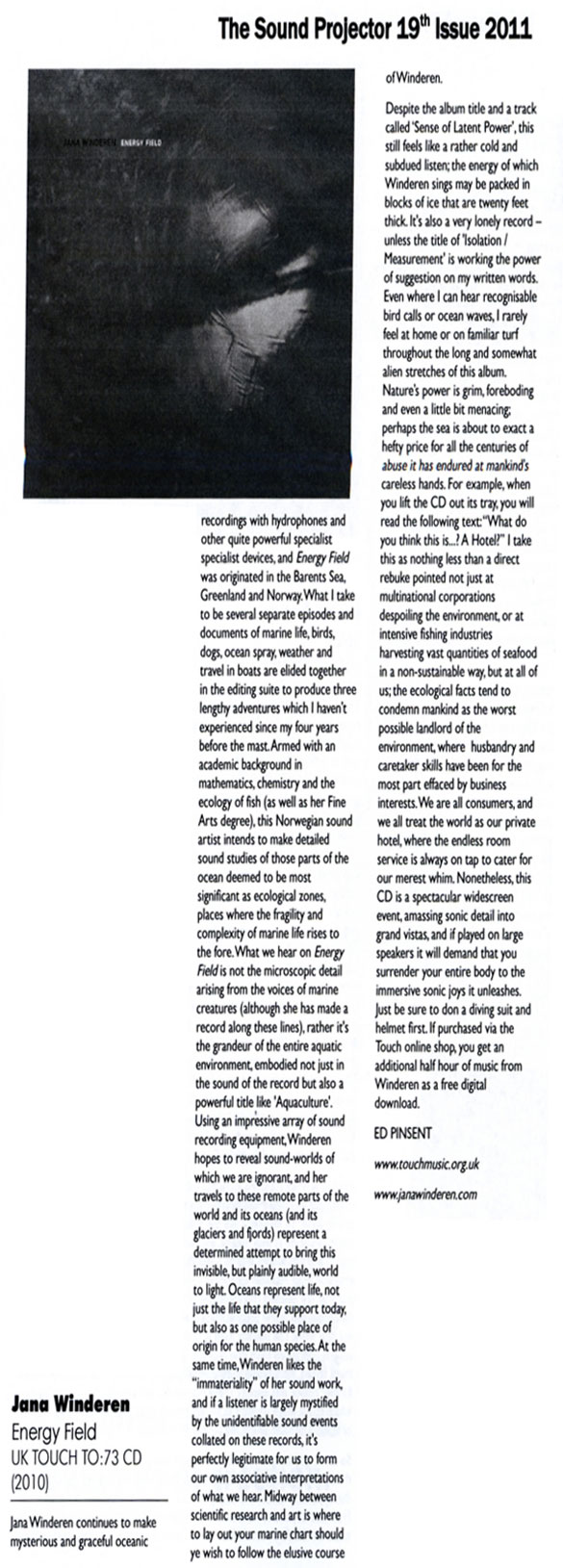
Foxydigitalis (USA):
“Energy Field” is the latest from Jana Winderen, a gatherer of field recordings hailing from Norway. While the emphasis of the album is on aquatic life and water in general, Winderen manages to fashion her recordings into loose musical narratives, which all makes sense as she has a background in both fish ecology and fine arts. Utilizing sounds culled from the Barents Sea, Greenland, and Norway, Winderen crafts a beautiful, melancholy, and engrossing listening experience that is deeply evocative of its marine sources.
Many of elements peppering the three long tracks of “Energy Field” are readily identifiable (bird calls, thunder, wind, rain, splashing water), but others that are not quite as clear (drones, creaks, rumbles, echoes, etc). Still, it is this mix of familiar and mysterious that makes this album work so well. Obviously, the sounds of water and the sea are recognizable to most people, but Winderen manages to expand the listener’s perceptions as to just what sounds exist in these contexts with some of the odder inclusions. Delving beneath the surface of the water, she manages to pick up the sounds of crustaceans and fish as they try to hunt or call to attract a mate. Given the general perception that the underwater world is a place of silence and calm, these representations of aquatic life are especially interesting to contemplate as the album unfolds.
Still, Winderen doesn’t draw back the curtain on her craft entirely (the notes in the CD reveal where she recorded, but not precisely what goes into each track, though the press release does offer a few clues). Ultimately, the listener is left to figure out just what is being heard with little explanation, which allows for the mind to wander and construct its own scenery. Still, even when things are at their most obscure, there is an overwhelming sense of experiencing a gray day near the water, owing largely to Winderen’s source material, but also to her amazing ability to assemble found sounds into cohesive, representational pieces. [Matt Blackall]
Tokafi (Germany):
Icy audio sculptures: Plunges you into the depths of Arctic waters.
For her new album Energy Field, sound artist Jana Winderen crafted icy audio sculptures from field recordings taken in Greenland, Norway, and the Barents Sea north of Greenland and Russia. Using a portable recording setup, the Norwegian artist and curator collected glacier, fjord, and ocean sounds ranging from ambient wind textures to cracking ice, lulling rhythms of lapping waves, and the low-end frequencies of ominous thunder. She then layered and edited those sounds into three compositions that collectively constitute nearly an hour of surprisingly musical sound art. Constantly churning textures, hypnotic long-tone oscillations, and a powerful sense of compositional arc make Energy Field a captivating and highly listenable experience that plunges you into the haunting depths of Arctic waters.
In her artist statement, Winderen writes that “in the depths of the oceans there are invisible but audible soundscapes, about which we are largely ignorant, even though oceans cover 70% of our planet.” This certainly is apparent on Energy Field, which documents an alien world of sounds that could as easily be generated from dated synthesizers as from the natural sounds of the ocean. It’s amazing just how evocative some of these sounds are. In the final minutes of the album, the high-pitched mating calls of fish weave over sustained dissonances constructed from a combination of wind and underwater hum. The result is a spine-chilling amalgamation at least as strange as anything conjurable by modern electronic music. In “Isolation Measurement,” creaking and cracking glaciers create a fizzing stereo effect from which one seemingly perceives moments of rhythmic regularity. As underlying bass currents seep beneath the texture and the sounds of birds and crashing waves become increasingly apparent, the composition hints at a climax before disintegrating into quiet gurgling.
A compositional arc of tension and relief pervades the entire album. And while it’s difficult (and perhaps unimportant) to discern how much of it is intentional versus circumstantial, it makes for a highly musical result that’s far more engaging than your typical “field-recordings as sound art” gallery installations. Sustained oceanic chords with an endless array of overtones ebb and swell over ominous low-end rumblings to generate harmonic movement and stasis. Polyrhythms emerge from the juxtaposition of churning waves and trickling water. And despite constantly changing textures, environmental consistencies of sounds, chords, and rhythms establish thematic unity to create cohesive compositions as opposed to collage-like layerings of field recordings.
Energy Field is as powerful musically as it is impressive conceptually. Winderen’s unique sonic space of naturally alien sounds and juxtapositions draws you into the depths of an unknown underwater world and holds you there. [Hannis Brown]
You can read an interview with Jana Winderen in Tokafi here (in English)
Aquarius (USA):
Paralleling what the Australian sound artist Tarab achieves through his magnificent albums, Jana Winderen collects an impressive array of field recordings and edits them into her compositions without much (if anything) in the way of digital processing. For Energy Field, Winderen traveled to the barren land-and-seascapes of Greenland, Norway, and the Barents Sea, using high-end parabolic microphones for the above ground recordings and hydrophones for the seaborne sounds, capturing creaks from massive glaciers, the slippery resonance of ice crevasses, the sounds of crustaceans (remember her cassette for the Tapeworm label, The Noisiest Guys On The Planet?), [no it wasn’t, it was on Ash International – ed.] the chatter of summertime birds, and huge passages of windswept vibration that sound more like one of BJ Nilsen’s swarms of drone than anything produced via natural means. Winderen presents three extended pieces that steadily undulate and crest, much like the patterns of the ocean when viewed from a considerable distance, and have been pocked with various tactile recordings of ice cracking, water dripping, the strange bellows from mating fish, and whatnot. Hypnotic, beautiful, and wholly compelling, Winderen’s Energy Field is another exemplary entry in the Touch catalog, and totally up our alley here at AQ.
Boomkat (UK):
This outstanding new Touch release is an album comprised of documents made by sound recordist Jana Winderen over a number of field trips to the Barents Sea, Greenland and Norway. Winderen’s focus takes in above-ground sounds of extreme Northern weather systems and the wildlife that inhabits such surroundings, but perhaps more significantly and insightfully, the Oslo-based artist makes probing recordings of sub-aqua environments/habitats using hydrophones. Winderen delves deeply into glaciers, fjords and the open ocean with her equipment, capturing incredible unseen worlds populated by baffling and wholly alien sounds. You’ll seldom have any idea as to what might be making some of these amazing noises, but among them are: “Sounds of crustaceans, fish such as cod, haddock, herring and pollock recorded as they are hunting, calling for a mate or orientating themselves in their environment”. The disc is divided into three lengthy pieces, each one assembled from a variety of different recordings, carefully layered and edited so as to give a flowing, seamless account of the various locales Winderen explored on her field trips. In terms of recording fidelity and all-round immersive brilliance, Energy Field is right up there alongside Chris Watson’s greatest works – it really is that good. Anyone with an affection for the art of sound recording will instantly adore this release; it’s an album that offers a consistently surprising and illuminating depiction of regions in our natural world that would otherwise be inaccessible to us.
VITAL (Netherlands):
This is my second encounter with the work of Jana Winderen, following ‘Heated: Live In Japan’ (see Vital Weekly 669), where she created a piece of music with the use of various field recordings. A very good piece of music, but nothing that leaped out of what we already heard by others in the same field (sorry of that bad line), like BJ Nilsen or Chris Watson, both of whom are also on Touch actually. Here she presents a new work made in Barents Sea (which can be found north of Norway and Russia), Greenland and Norway, in cold sea, glaciers. Apparently we are supposed to hear fish (cod, haddock, herring, pollock) hunting, calling for a mate or just trying to find their way. I am not sure, and bound to think its not, but it seems that Winderen has added some electronic processing to the sounds she recorded. Or maybe its just the drone of a trawler also picked up with her hydrophones. Again I must say this is a beautiful work, which if you don’t know much about the fact that it is recorded below sea level, most of the times, could pass on as a high and mighty work of drone music. Like so many genres discussed in Vital Weekly (ambient, noise, field recordings), its hard to stand out with a particular work. Jana Winderen delivers once again a great work, which can easily meet up with the best in her field. No wonder she is on a high quality label like Touch. [FdW]
Mapsadaisical (UK):
“I can live at sea! The sea forgives all! Unlike those mean old mountains. I hate them so much”. I wonder how many albums on Touch Homer Simpson had heard before he came to that ever-so-slightly life-changing conclusion. Very few, I suspect. A number of releases on Touch have had maritime themes, including BJ Nilsen’s The Short Night and Fennesz’s The Black Sea, although most celebrated may be the field recordings (if you can call under the sea a “field”) of Chris Watson. These records are fascinating explorations of the mysteries of the ocean, but leave you with a distinctly unsettled feeling, unsure about what exactly you’ve just heard, but in no doubt about the sea’s awesome dark power. To this collection of releases we can now add Jana Winderen’s Energy Field.
Jana Winderen possesses an interesting CV which lends her perfectly to this piece of work. An artist with a background in fish ecology (as well as maths and chemistry) who has been responsible for a number of light and sound-based installations on nautical subjects, Winderen appears to have an incredible understanding of how to capture and present the unknowable, the world beneath the ocean’s surface. So strange is this place that if you didn’t know anything about how this was recorded (in the seas around Norway, Russia and Greenland) you’d struggle to place the sounds. In fact, it isn’t easy even if you DO know. “Aquaculture” has a booming pulse, a deep lowing which sounds almost choral. Is it a distant boat? A huge whale? What about that horrifying roar: is it thunder or a piece of the ice shelf collapsing into the sea? The extraordinary creaks of “Isolation/Measurement”: are they old boat doors, or dolphin chatter? “Sense Of Latent Power” is full of sparks and clicks which sound almost like a fire ripping through dry wood at first, but which might be more explicable as a melting glacier. These sounds are fascinating in themselves, but they are layered up to powerful and almost musical effect, deep drones and high frequency pulsations interspersed with this narrative of unfathomable events, building to a rather frightening climax. Energy Field is an excellent record which is full of dark secrets, and in which occasional complete immersion is highly recommended. I’m not sure I’d want to live there though, Homer.
de:bug (Germany):
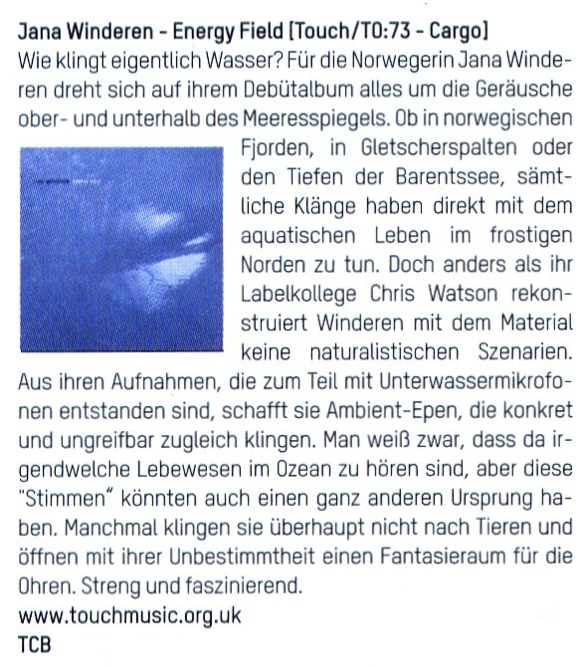
GP (Sweden):
5/5
Nere i havsdjupen finns mängder av outforskade ljudverkligheter som människan fortfarande vet mycket litet om. Sedan drygt ett decennium ägnar sig den norska ljudkonstnären Jana Winderen åt att kartlägga dessa okända världar med hjälp av hydrofoner, avancerade mikrofoner och digital hårddiskbandspelare.
Det är fascinerande klangrum som öppnar sig på detta hennes egentliga debutalbum (Winderen har tidigare givit ut en liveinspelning från en konsert i Japan, recenserad i GP för ett år sedan). De fält inspelningar som ligger till grund för de tre långa kompositionerna är gjorda i Barents hav och i vattnen utanför Grönland och Norge. Lyssnaren får ta del av kommunikationssignalerna från olika kräftdjur och fisksorter som torsk, kolja, sill och stillahavsbleka när de jagar, ägnar sig åt parningsriter eller orienterar sig i omgivningen. Resultatet blir ett slags klingande äventyrsberättelser, mystiska och oöverblickbara och samtidigt glasklara i fördelningen av klangfärger och frekvensomfång. Det är svårt att inte förtrollas. [Magnus Haglund]
Walter Wehus musikk (Sweden):
Jana Winderen finner evigheten på havbunnen
Feltopptak kan være en vrien sjanger for en kunstner å begi seg ut på. Kunsten er å kombinere timesvis med opptak av ulike fenomen til en sammenhengende enhet, som i tillegg gjerne skal ha en god flyt. Norske Jana Winderen har dratt ut på tokt i Barentshavet, på Grønland og langs norskekysten med opptaksutstyr vanligvis forbeholdt forskere. Her finner hun den forblåste fuktigheten på havoverflaten, men også lyden av isbreer og av fisk langt nede i havet.
Albumet er delt inn i tre lange spor, som klokker inn på rundt femti minutter tilsammen. Winderen har lykkes i å sette sammen tepper av lyd som forteller en historie om de mest øde stedene man kan tenke seg på planeten. Det er bare takket være presseskrivet vi kan vite at noen av lydene tilhører «…torsk, kolje, sild og berlevågfisk som kaller på sin make og orienterer seg i miljøet» (Winderen har til alt overmål også studert fiskeøkologi ved UiO). «Energy Field» er en blanding av dronende ambient, knirk og dyphavsrumling, ikke gjort mindre imponerende ved at alt er basert på naturopptak.
Beyond the Noize (France):
Jana Winderen serait un peu un commandant cousteau musical, avec du talent. Cette illuminée se ballade dans des endroits jugés essentiels pour la compréhension des écosystèmes marins, armés de ses micros spéciaux (déjà ils vont dans l’eau hein) en essayant de capturer l’essence de ces sonorités. Dans ce disque, Jana s’attelle aux nord de la Norvège et de la Russie mais aussi au groenland. Ses micros sont enfoncés de toutes parts, dans des glaciers, dans la moindre interstice qui lui permettrait de graver sur support ce qu’elle considère comme essentiel pour peindre un paysage sous marin rendu réaliste de l’endroit. ENergy fields est donc clairement froid, un disque d’ambiant/field recording nous présentant les fonds marins congelés, avec une vie propre et des éléments qui l’accompagnent. On entend cette vie, cette vie sous marine mais aussi la vie des éléments, qui viennent troubler (ou plutot bercer par moment) ce panorama glacial (iodé) qui se dresse sous nos yeux. C’est toute une vie qu’Energy fields nous propose, en allant de la chasse de certains poissons, à leur orientation même. Le rendu final (en tryptique) est d’une rare cohérence (j’imagine le travail stakhanoviste qu’elle a du réaliser pour trier quantités d’enregistrements et les agencer de manière à créer un disque qui avance, qui raconte quelque chose), avec un premier long morceau qui nous présenterait les lieux et les personnages, une suite qui les rendrait plus vivant, avec un morceau moins contemplatif, presque dark par moment (avec ces sonorités grincantes et cette sensation que les eléments se déchainent). Puis peu à peu Jana nous plonge de manière plus profonde, comme si on s’enfoncait dans un grand vortex sous marin où peu à peu on apprend à respirer et à s’orienter pour trouver la lumière au bout du tunnel. [Macho]
Ambientblog (Blog):
Field Recordings come in many varieties. From the documentary recordings, as true to nature as possible, to environmental soundscapes, using recorded sounds to create a completely new environment. Presenting music by recording artists like Jacob Kirkegaard, Chris Watson and Jana Winderen, Touch is definitely one of the finest labels in presenting this form of sound-art.
After releasing her beautiful (live) recording “Heated: Live in Japan” last year, Jana Winderen’s “Energy Field” is her new full album on Touch. More-than-full, actually, for (on-line) buyers also receive a free download of Jana’s live performance on the Today’s Art festival in Den Haag, in 2009. On Energy Field, Jana Winderen takes us on an acoustical journey to the unknown marine ecosystems of the Barents Sea (north of Norway and Russia), to the crevasses of glaciers, the fjords into the open ocean, and the open spaces of Greenland. Her education in Fine Arts, as well as in Mathematics, Chemistry and Fish ecology ensure a thorough background knowledge of the work she is presenting.
“I have been occupied with finding sounds from unseen sources of sound, like blind field recordings. […] In the depth of the oceans, there are invisible but audible soundscapes, sbout which we are largely ignorant, even if the oceans cover 70% of our planet. I am also experimenting with different types of microphones to collect sounds which are not obviously recognisable, but give room fro broader, more imaghinative readings”. The three tracks on Energy Field are deeply isolated and desolate. No matter where you listen, be sure to have a sweater nearby because you’re gonna feel the cold.
The album starts of with some familiar, recognisable of animal sounds, but within a few minutes you’re transported to the Deepest of the Deep.In fact, music cannot go much deeper than this, literally. Somehow, it reminded me of the best work of Sleep Research Facility, although the starting point of these projects is entirely different.
Brainwashed (USA):
Field recordist Jana Winderen’s latest finds her indulging her long-standing passion for capturing the sounds of hidden environments yet again, this time in and around the Barents Sea region of the Arctic Ocean. Using an array of specialized microphones and a great deal of editing, she has woven the resultant decontextualized sounds into an immersive suite of frozen and mysterious desolation.
Energy Field is the sort of album that only a very specific type of person could have made and Jana Winderen is a very specific type of person: an artist living in Norway with a background in both science and fish ecology. Appropriately, it is also the sort of album that only a very specific type of person will enjoy, as it is composed purely of field recordings with no conventionally music elements. Also, its complexity can only be fully appreciated with headphones.
Despite the superficially limited scope of Winderen’s recording trips, she managed to accumulate quite a wide palette of sounds to work with. Aside from the deep undersea rumbles and hums that she was able to capture with hydrophones, Jana also spent some time harvesting sonic raw material from glacier crevasses, fjords, and various terrestrial areas of Greenland and Norway. As such, the three lengthy works collected here incorporate a number of disparate textures: howling winds, pleasantly burbling streams, breaking waves, crashes of thunder, chirping birds, yowling dogs, hungry and/or horny fish, cracking and straining sheets of ice, and a host of other sounds that are not readily identifiable.
The degree to which Winderen has tweaked the recordings is not entirely clear. Obviously, she cleaned them up a bit and combined them in strange and unexpected ways, but they still basically sound recognizable (although I regrettably cannot identify exactly what a crustacean sounds like). At times, some sounds seem to reverberate or echo cavernously in a way that suggests studio enhancement, but it is entirely possible that such resonance is natural.
The emphasis here is, unsurprising, quite firmly centered on process, concept, and the simple wonder of unearthing previously unheard sounds. Nevertheless, Jana does an admirable job of shaping her material into a listenable and quasi-musical arc. For example, there are distinct crescendos of deep multi-tracked bubbling and roaring waves, ominous passages of deep underwater drones, pleasant stretches of placid rippling, and shimmering beds of eerie oscillation and dissonance. It is an oft-mesmerizing soundworld to get drawn into- at its best, Energy Field is able to convey something far larger than any traditional musician could have: the disturbing enormity of the world that we never see.
The Wire (UK):
It’s good to be wary of field recordings, even when they are as well-recorded as those by Norwegian sound artist Jana Winderen. Of course you’ll sound great if you reproduce the formidable marine roar of the Arctic Ocean, as Energy Field does, but you’re essentially just bootlegging nature. What is impressive about Jana Winderen’s work, though, is the way its artificial elements are integrated so consistently into the landscape that they feel like entirely organic extensions of it. As when she folds a crackling spume of static into the swash of turned beach pebbles, or captures the slow creaking of a glacier (tree, signpost?) and scatters its echoes like skimming stones across the stereo field. Winderen’s work makes sly, additive interventions in nature, in a similar way to Richard Long’s Land Art, illuminating and re-patterning musical features of the environment with an awed respect. [Nick Richardson]
[This is of course completely incorrect. There are no “artificial elements …integrated…” that is the whole point. They are all field recordings and it states clearly on the album artwork where they were recorded. – ed.]
Chronicart (France):
Entre le voyage au Pôle Sud du vétéran Chris Watson pour l’indispensable série de podcasts du label Touch et celui de Biosphere autour du Sørfjorden, l’hiver fut pour ainsi dire riche pour les amateurs de matières sonores en provenance du Grand nord. Membre du collectif Freq_Out et exploratrice invétérée de notre monde aural, l’artiste sonore Jana Winderen est également partie à la pêche aux diamants sonores au-delà du cercle polaire pour ce premier album sur Touch, dans la Mer arctique de Barents au-dessus de la Norvège et au Groënland. Véritable artiste sonore plutôt qu’investigatrice encyclopédiste, la Norvégienne voyage surtout pour ramener des matériaux bruts à la mesure de son esthétique paradoxalement surnaturelle et raffinée. Armée d’une pagaille d’hydrophones (des transducteurs qui permettent de capter les oscillations acoustique de l’eau, c’est-à-dire « d’enregistrer » sous l’eau) et de micros paraboliques dernier cri (ce genre), Winderen semble n’épier les recoins acoustiques des fragiles milieux et biosphères arctiques que pour leur emprunter leur âme et leur force secrète et se repaître de leur beauté luminescente.
Montages habiles d’événements crépitants et de mystérieuses mélopées étirées, les trois plages électrisantes et étincelantes de ce bien nommé Energy field raviront donc moins les amateurs d’écru scientifique que les romantiques les mieux disposés à l’émerveillement et à la contemplation. L’ouverture du premier morceau Aquaculture, qui convie chiens de traîneau, bise glacée en collisions de bouts de banquise ( ?) ouvre certes la fenêtre sur un décor identifiable type cinéma pour l’oreille, mais nous plonge vite la tête six mètres sous la surface de l’océan pour nous faire entendre sirènes et fantômes. Quelques courts effets de zoom saisissants mis à part (dont des exhalaisons d’air entre glace et eau, ahurissantes à l’oreille, qu’on entend aussi dans le Journey south de Chris Watson), Energy field s’apparente même idéalement à l’idée qu’on s’était toujours faite de ce joli cliché musical de l’electronica du milieu des années 90 qu’on appelait l’ambient arctique et qu’on désespérait d’entendre dans l’ambiant à nappes des vieux Biosphere (le classique Substrata ou les Polar sequences co-signées avec HIA en 1996) ou celui tout gris des albums de Thomas Köner sur Barooni : des longs aplats presque immobiles de matières à rêver aux origines indéterminées, dont les forces de gravité prodigieuses attirent jusqu’aux photons de lumière dans leur giron. Mystérieux et magnétique, Energy field est simultanément un don de la planète et l’oeuvre très personnelle d’une artiste avec laquelle il faudra compter, et s’y enfouir encore et encore (si possible au casque, tard dans la nuit) est un ravissement. [Olivier Lamm]
Sonic Seducer (Germany):
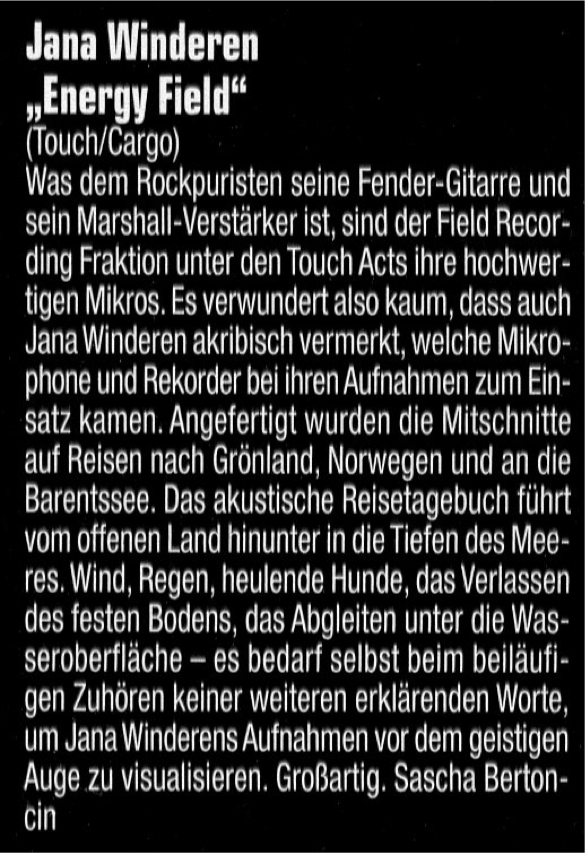
Polychromic (France):
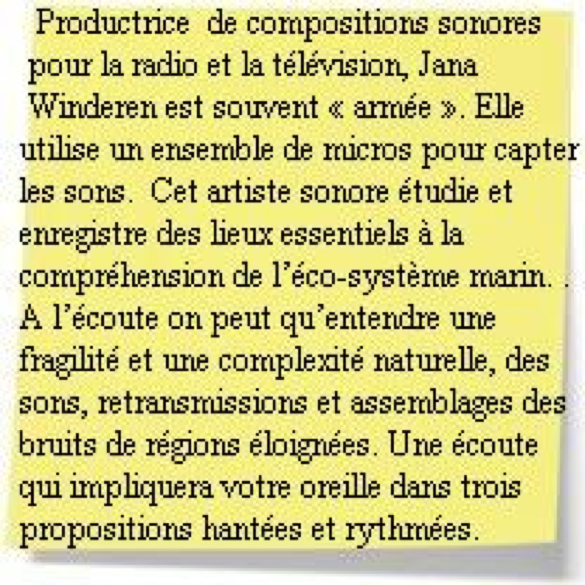
Armchair Dancefloor (UK):
Fans of Chris Watson’s field recordings should be very excited by Jana Winderen’s excellent new album, recorded in the Barents Sea, Greenland and her native Norway. Blending the sounds picked up by her hydrophones, omni mics and parabolic reflector mic (not a lot gets past that kind of array) with electronic augmentation in post-production, Winderen’s compositions begin with deceptive simplicity before building into dramatic, detailed and highly controlled works.
From the cawing of birds on ‘Aquaculture’ to the icy creaks and squeals, hissing breachings and subaquatic reverberations of ‘Isolation/Measurement’, you’re constantly reminded that natural maritime sounds are the instruments with which Winderen creates music, as opposed to her work being a straightforward documenting. That’s not remarkable in itself, but the skill with which she forms her material throughout Energy Field, and most strikingly on closing track ‘Sense of Latent Power’, most certainly is. [Chris Power]
Dar Entried (Belgium):
Sinds haar debuut op Touch Music -genaamd Heated, live in Japan- zijn we hier fan van de muziek van Jana Winderen. U vindt van dit minialbum en tevens van haar K7 The Noisiëst Guys On Earth dan ook enthousiaste recensies terug op onze site. Met plezier voeg ik deze hier ook aan toe, want het moet gezegd: Jana weet met haar muziek weer werelden te openen. De werkwijze hiervoor is ondertussen gekend: met microphones en hydrophones gaat ze aan de slag om geluiden opte nemen van allerlei soorten vissen en schaaldieren tijdens hun dagdagelijkse bezigheden als paaien, op jacht gaan, eten, territorium afbakenen,… noem maar op. Hiervoor stuurde ze deze keer haar hydrophones naar de -op dat vlak onbekende- diepten van de noorse zee en nam ze ook veldopnames op van de wereld onder het ijs. Uiteraard gaf dit weer een heel gamma aan geknor, geknars en gepiep; en ja: Jana weet doorgaans wel welk dier welk geluid gemaakt heeft (wat geen sinecure is). Daarbij voegde ze ook nog de veldopnames die ze samen met Marc Behrens (zie recensie van zijn album op het Crônica label) maakte in het noorse Sleppet. Vervolgens sloeg ze aan het mixen en vervormen. Wie Heated in huis heeft weet waaraan zich te verwachten… Zeggen welke van de drie werkstukken het beste is, doen we niet. Alle drie nodigen ze ons uit om onze bekende percepties los te laten en ons onder te laten dompelen in een universum dat het onze niet is. Laat dààr nu precies de kracht zitten van Jana Winderen’s muziek… Ik verwijs wéér eens naar Soundtrack for the Aquarium van de vlaamse Hybryds (we spreken hier van de jaren ’90) al was het maar om te zeggen dat Jana vérder gaat dan deze Hybryds-klassieker en waarschijnlijk dan eender wie… Zo goed als essentieel voor liefhebbers van merkwaardige klanktapijten. 8/10 [Jan Denolet]
D-Side (France):

ae mag (Germany):
Bereits in Issue 5 besprochen, landet nun das erste Album von Jana Winderen auf dem Redaktionstisch. Der von Winderen besuchte Klangabyss spielt sich dabei auf der unter NN liegenden Ebene ab, mittels Hydrophon und empfindlicher Mikrophonie zeichnet sie den unterschwelligen Kosmos der Tiefseefische ab, inklusive Paarungsrufe und bewegungssensitives Beutejagen. Obgleich die dabei gewonnenen Aufnahmen einer ungleich dezenten digitalen Bearbeitung unterworfen wurden, wirken die alienhaften Schreie und Rufe der Fjorde und Seen wie die Impulse eines Weltraumtransmitters auf Radiobasis.
Inwieweit Jana Winderen den Verlauf der Aufnahmen athmosphärisch beeinflusst hat, sei dahingestellt, Fakt ist, dass ihre sensible Ausarbeitung viel vom ursprünglichen Charme der Wasserwelt beibehält, ohne den natürlichen Sound in seiner Authentizität zu beschneiden. Der dronehafte Hintergrund der See erinnert mit seinen druckvollen Mitten an die Druckverhältnisse submariner Wassergrotten, während die knistrig-hochfrequenten Schnarr- und Strömklänge der Unterwasserstrudel und Verwirbelungen aufgrund ihrer Feinheit wie störende Flecken auf dem kraftvollen dunstigen Vordergrund wirken. Und wenngleich Winderen mit ihrer konzeptuellen Unbekümmertheit sich sicherlich neben altgedienten Feldrekordern wie Chris Watson stellen kann, wirkt ihr Werk stets dann am besten, wenn der Unterschied zwischen reiner Naturaufnahme und digitaler Nacharbeitung geradezu auf der Horizontalen verschwimmt. 4/5
Blow Up (Italy):

Chronicart (France):
Entre le voyage au Pôle Sud du vétéran Chris Watson pour l’indispensable série de podcasts du label Touch et celui de Biosphere autour du Sørfjorden, l’hiver fut pour ainsi dire riche pour les amateurs de matières sonores en provenance du Grand nord. Membre du collectif Freq_Out et exploratrice invétérée de notre monde aural, l’artiste sonore Jana Winderen est également partie à la pêche aux diamants sonores au-delà du cercle polaire pour ce premier album sur Touch, dans la Mer arctique de Barents au-dessus de la Norvège et au Groënland. Véritable artiste sonore plutôt qu’investigatrice encyclopédiste, la Norvégienne voyage surtout pour ramener des matériaux bruts à la mesure de son esthétique paradoxalement surnaturelle et raffinée. Armée d’une pagaille d’hydrophones (des transducteurs qui permettent de capter les oscillations acoustique de l’eau, c’est-à-dire « d’enregistrer » sous l’eau) et de micros paraboliques dernier cri (ce genre), Winderen semble n’épier les recoins acoustiques des fragiles milieux et biosphères arctiques que pour leur emprunter leur âme et leur force secrète et se repaître de leur beauté luminescente.
Montages habiles d’événements crépitants et de mystérieuses mélopées étirées, les trois plages électrisantes et étincelantes de ce bien nommé Energy field raviront donc moins les amateurs d’écru scientifique que les romantiques les mieux disposés à l’émerveillement et à la contemplation. L’ouverture du premier morceau Aquaculture, qui convie chiens de traîneau, bise glacée en collisions de bouts de banquise ( ?) ouvre certes la fenêtre sur un décor identifiable type cinéma pour l’oreille, mais nous plonge vite la tête six mètres sous la surface de l’océan pour nous faire entendre sirènes et fantômes. Quelques courts effets de zoom saisissants mis à part (dont des exhalaisons d’air entre glace et eau, ahurissantes à l’oreille, qu’on entend aussi dans le Journey south de Chris Watson), Energy field s’apparente même idéalement à l’idée qu’on s’était toujours faite de ce joli cliché musical de l’electronica du milieu des années 90 qu’on appelait l’ambient arctique et qu’on désespérait d’entendre dans l’ambiant à nappes des vieux Biosphere (le classique Substrata ou les Polar sequences co-signées avec HIA en 1996) ou celui tout gris des albums de Thomas Köner sur Barooni : des longs aplats presque immobiles de matières à rêver aux origines indéterminées, dont les forces de gravité prodigieuses attirent jusqu’aux photons de lumière dans leur giron. Mystérieux et magnétique, Energy field est simultanément un don de la planète et l’oeuvre très personnelle d’une artiste avec laquelle il faudra compter, et s’y enfouir encore et encore (si possible au casque, tard dans la nuit) est un ravissement. [Olivier Lamm]
Playground (Spain):
¿Pueden los field recordings emocionar? Sí, si los procesa Jana Winderen. La artista británica se sirve principalmente de grabaciones efectuadas en las profundidades del Báltico para componer tres collages de belleza, obviamente, abisal. No es que tengan mucho que ver en el aspecto formal, pero a mí me ha hecho rescatar de los fondos de mi discoteca el “Cirque” de Biosphere y el “Azoic Zone” de Francisco López. Por si les sirve de pista.
SA (Spain):
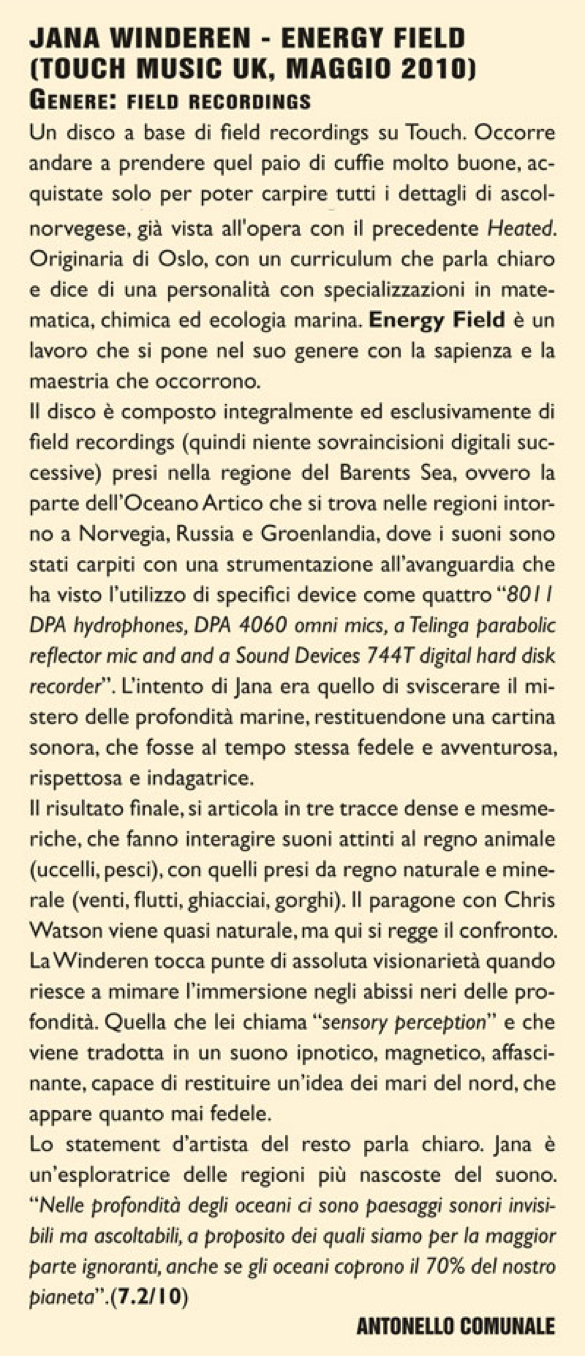
Beat (Germany):
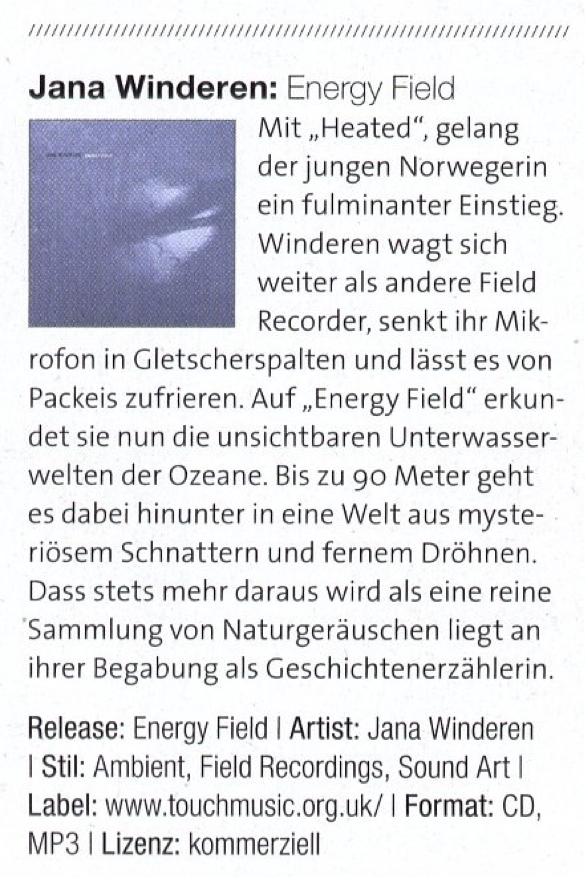
Dusted (USA):
The three track titles on Energy Field sum up Jana Winderen’s mission and approach: “Aquaculture,” “Isolation/Measurement,” and “Sense of Latent Power.” Her work moves away from detached observation toward heavy, expressionist rendering. Moreover, unlike her freq_out partner and Touch label mate Jacob Kirkegaard, Winderen seems driven more by her own passion, rather than the strength of her concepts. This is immersive and powerful creation first, “field recordings” second.
Winderen crafts Energy Field from recordings made in and around marine ecosystems in the Barents Sea, Greenland and Norway. What emerges is something similar to the mind-blowing underwater films of Jean Painlevé — a closed-off environment processed, then displayed for consumption. Where Painlevé aims for euphoric psychedelia, Winderen simply overwhelms. The sounds are mostly distinct, but her layers and edits turn the tracks into dense, hypnotic drones.
Indeed, any sounds that resemble standard field recordings are quickly subsumed into the overall haze, and if a clear sound happens to be reintroduced, it’s often at a disarming level in the mix. On “Isolation/Measurement,” what sound like wooden boards creaking pop out like something off one of the Autechre/Hafler Trio collaborations. “Aquaculture” and the first half of “Isolation/Measurement” follow this pattern closely, but the second half leads towards almost pure drone, and except for some scattered water and bird sounds, “Sense of Latent Power” gives all of its 20 minutes over to dark rumbles and jarring overtones. As a metaphor for both the deceptive quiet of the sea and Winderen’s role as recorder, selector, and artist, it’s an apt title. [Brad LaBonte]
Fear Drop (France):
C’est dans le vent et plus encore dans l’eau que Jana Winderen absorbe les formes les plus infimes et les plus diluées des résonances ambiantes. S’agirait-il de retrouver le grain de poussière dans la brise, le sel dans le courant, la fêlure dans la banquise, que l’entreprise ne serait pas plus difficile. Pour Energy field, elle a parcouru les mers boréales, et certains de leurs blocs de glace. Elle a pris sur le vif les sons de l’eau, des poissons, des crustacés, des craquements de la glace. Il y a d’autres musiciens (s’il ne faut qu’un nom ce sera celui de Cédric Peyronnet) qui ont pris sur eux cette nouvelle expression de la poésie, que la géopétique de Kenneth White a appelée de ses vœux : ils composent le chant du lieu (ou du voyage), la strophe sonore (musicale) d’un environnement, à l’aide uniquement des sons qu’il a offerts, comme un plasticien aurait à cœur d’illustrer un endroit d’élection exclusivement avec les matériaux et les matières qu’il y aurait collectés. Pareillement, Jana Winderen a recueilli tous ces sons pour composer trois vastes pièces, musicalisant les eaux polaires. Le style, dans le sens le plus pointu de ce mot, est appliqué avec la méthode tactile de la musique ambiante. Ici, les nappes sont tissées de brume et de résonances subaquatiques, les pulsations fantômes semblent issues du plus profond de l’iceberg, le rare crépitement sorti de la gelure attaquée. Enchantée de bleu et de gris, la musique de Jana Winderen, plus encore que sur Heated son disque précédent, s’habille d’eau et prend ses formes, ses goûts et ses tourments. Il se trouve que c’est l’eau du nord où la vie, rare, est à peine moins fluide, et cela ne cesse d’ouvrir l’oreille à l’insondable, perdu dans les profondeurs d’encre. Le drone a cette fausse légèreté, celle de l’engourdissement, déjà fécond d’un rêve arctique, proche, on ne sait, d’un grand moment de début ou de fin. [Denis Boyer]
Paris Transatlantic (France):
Winderen recorded the sources for Energy Field in the Barents Sea, Greenland and Norway through hydrophones, a parabolic reflector and assorted microphones. The consistently engaging results amount to one of the most striking records dealing with environmental materials heard in years, unquestionably belonging among the finest Touch releases in recent times. In “Aquaculture”, marine sounds and voices are fused into a gigantic accumulation of resonant currents and overwhelming reverberation, becoming one and the same with our own breathing rhythm. The extremely detailed noises and squeaks opening “Isolation/Measurement” give an idea of this Norwegian artist’s ability in capturing the essence of apparently irrelevant moments, first attributing a musicality to them then contextualizing the products in a larger frame where the listener is transported on site without moving, such are the intrinsic qualities and the vividness of the details. Again, what emerges is the impression of massiveness and, contemporarily, of rarefaction that the overall textural complexion elicits. “Sense Of Latent Power” is characterized by the (unfortunately brief) appearance of an unspecified animal’s chattering surrounded by the stifled roar generated by the assemblage of underwater recordings, which in the end are splendidly enhanced by a heavy equalization and put adjacent to additional idioms by aquatic protagonists, adding oneiric nuances to the imposing final blur. The silently persistent nature of the liquid features of this track contribute to a glorious spectacle of different gradations – concrete versus ethereal – that would convince even a cold-hearted sceptic. Four listens in less than 10 hours tell it all. [Massimo Ricci]
Bodyspace (Spain):
Um quarto de hotel, o fundo do mar e um monte de hidrofones.
Jana Winderen averigua cada uma das pedras que possa ocultar uma dimensão à partida invisível. Feito à sua imagem, um disco tão abundante como Energy Field garante, logo à partida, que por aqui anda uma investigadora insaciável dos sons que escapam ao radar mais mundano. Ao que parece, a norueguesa armou-se com o melhor equipamento de gravações de campo e partiu para as paragens mais remotas do Mar da Noruega, Mar de Barents e todo o oceano que rodeia os glaciares. Se toda esta imagem parece estupidamente romântica, o disco em si nada faz por camuflar essa mesma sensação de isolamento, que lá está bem escancarada nos corvos de um Edgar Allan Poe e no barulho do mar revoltoso que associaríamos a um Hemingway. São pesos pesados da literatura, e devem ser mencionados com cautela, mas Energy Field exibe a barba épica necessária para que não hajam suspeitas quanto ao seu porte.
Para mais, toda esta atenção prestada ao reino submarino não é um mote exclusivo de Energy Field e marca também presença na cassete de tiragem limitada The Noisiest Guys on the Planet (não, não são os Fuck Buttons), que presta a sua peculiar homenagem à criatividade e riqueza dos ruídos produzidos pelos animais marinhos com dez patas. Como se percebe, a missão quase exaustiva de Jana Winderen não tem um propósito vulgar.
Estranhamos depois ver, no interior do digipack, fotos de um quarto de hotel e a seguinte pergunta em dois tempos: What do you think this isŠ? A hotel? Com isto (e com a ambivalência dos sons oceânicos que parecem o chiar de portas velhas), não fica de parte a hipótese de Energy Field ser um disco que procura explicar como o fundo do mar, tal como um quarto de hotel, é um espaço com uma memória vastíssima e em grande parte desconhecida. Os sons atípicos, colhidos numa corrente fria situada numa posição inferior a uma corrente quente, podem até ser, num quarto de hotel, aquilo que ficou conhecido como secret wall tattoos, ilustrações feitas por debaixo de espelhos e quadros pregados nas paredes de pensões e motéis. As secret wall tattoos não são sequer aparentes quando alguém entra num quarto, ainda que lá estejam. A fertilidade musical do mais profundo oceano escapa muitas vezes ao consciente, mas ocupa cada minuto de Energy Field. [Miguel Arsénio]
Bad Alchemy (Germany):
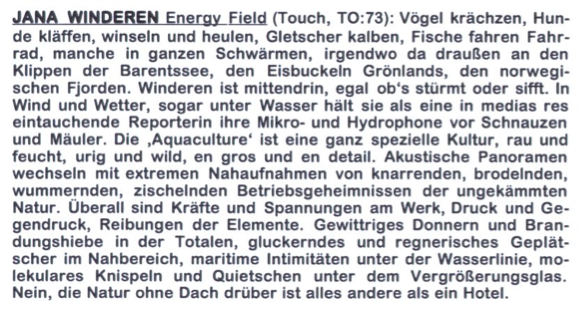
mcd (France):

Audiodrome (Italy):
Un disco così può generare righe e righe di luoghi comuni: la natura che è sempre meglio dell’uomo, i misteri del mare, l’ecologia, per non parlare delle infinite discussioni su quanto la tecnica con cui è realizzato sia arte o cos’altroŠ
Ciò che passa per lo stereo, al di là di tutto, è il lavoro che Jana Winderen fa su una serie field recordings raccolti nelle acque delle regioni artiche. Il cd esce per la grandiosa Touch, ma potremmo essere per certi versi dalle parti del catalogo Glacial Movements e ancora di più da quelle di Olhon di Zairo e Massimo Magrini (Bad Sector), anche loro dediti a registrare “in profondità” (l’ultimo loro album, del resto, ha per titolo Underwater Passage). “Profondità”, del resto, è una delle parole chiave di molta ambient e anche di Energy Field, basta sentire larghe parti di tutte e tre le tracce, che in alcuni momenti stanno su basse frequenze devastanti tipo Lull e in altri sono sconfortanti e conducono verso il nulla quanto Caul. Alla profondità va associato il senso di smarrimento dato dallo scoprire un mondo di suoni illuminato dai microfoni e dall’editing, anche se chi segue il genere già un po’ sa quanto innaturale possa essere la natura, ma si sta subito tornando sui luoghi comuni: buon (e involontario) dark ambient senza mostri, spettri e/o canti gregoriani. Fabrizio Garau]
Gomag (Spain):
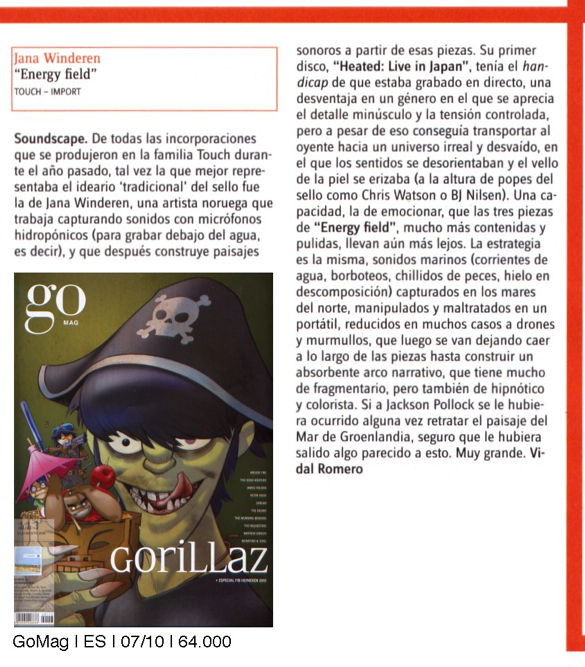
Arpeggi (Italy):
Territori naturali, trascrizioni che demarcano l’austero paesaggio dell’Oceano Artico, dal principio ostili ed intransigenti ma inevitabilmente tramutati -nei microfoni della norvegese Jana Winderen- in palpabili stati emotivi.
Energy Field combina registrazioni di campo, accorpandole a accostandole ma senza mai sovrainciderle con ulteriori forme o frammentarne il suono, ed ecco facilmente riconoscere la fonte, che sia l’acqua, lo sfrigolio dei ghiacci, la natura animale o quella minerale (venti ,gorghi).
Non lontano dall’ecologia sonora di Andrea Polli che nel 2009 con Sonic Antartica e le sue buone discipline elettroniche era riuscita a combinare con attenzione ed estetica precisione i paesaggi neutrali dell’Antartico.
Ma a differenza di quest’ultima la Winderen è capace di restituire attraverso un’evidente progettualità fonica, un’acuta percezione sensoriale ed in sole tre tracce un ipnotico mantra subacqueo, regalando -come aveva gia dimostrato con Heated nel 2009- una nuova forma d’arte alla bioacustica.
L’importante è che a prendere vita siano profondità marine o regioni nascoste al suono chiamate a restituire alle orecchie paesaggi interiori fatti di cinematiche progressioni e che trovano espressione nella suggestione di detriti, suoni desolati e scabri. Se poi a forgiarli ci si aggiunge abilità e maestria di chi ha alle spalle anni di esperienza la suggestione è fatta. (7) [Sara Bracco]
Gonzo Circus (Belgium):
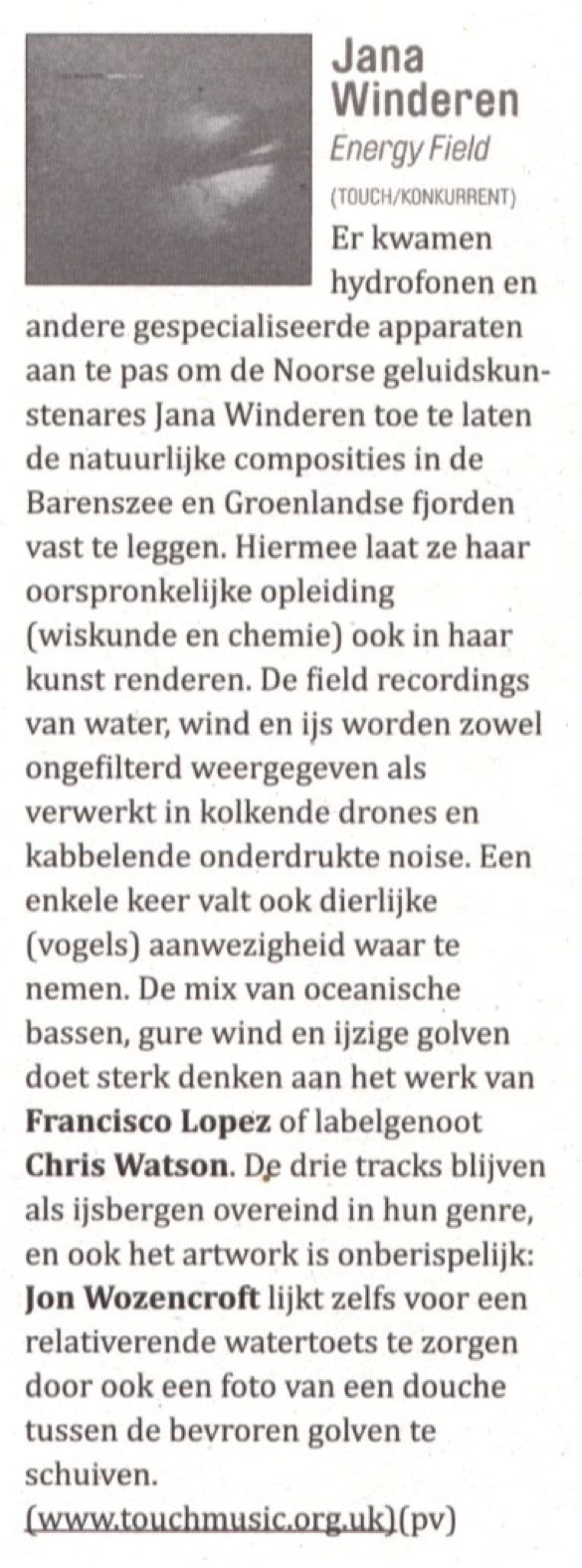
RifRaf (France):

His Voice (Czechia):
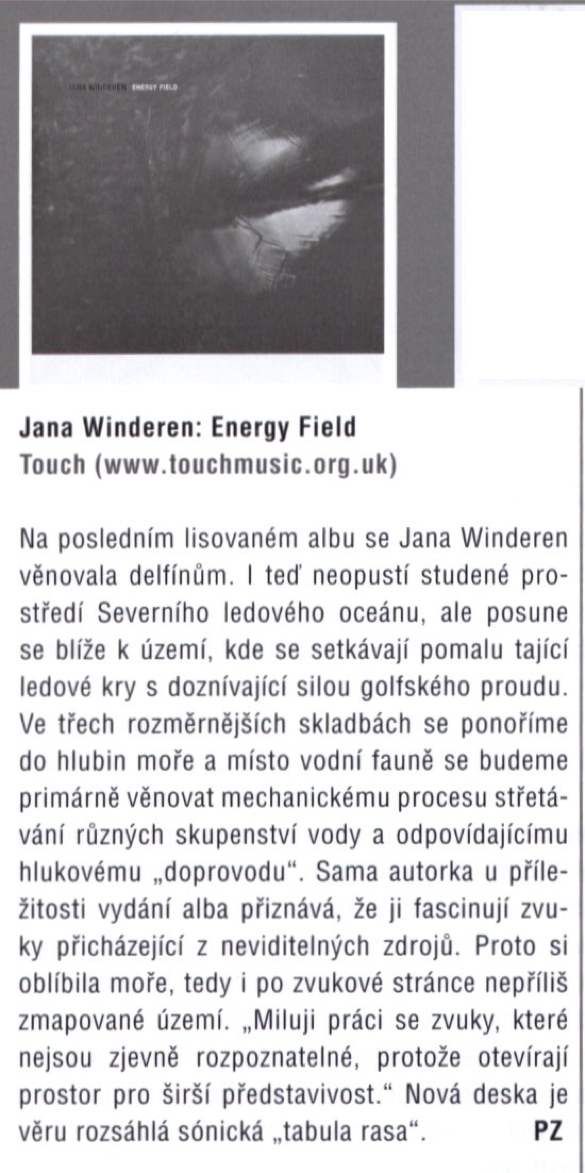
musiquemachine (UK):
A fair number of us, I think, give some token credence to the concept of the earth as a living thing. This album—the latest since Winderen’s amazing Heated: Live in Japan—brings that notion to life in a way that’s as immediate and physical as the previous album. Like that record, I didn’t just want to listen to this music; I wanted to make a meal out of it.
Across all three tracks—“Aqualculture”, “Isolation/Measurement” and “Sense of Latent Power”—Winderen mixes a broad palette from the sounds of nature into throbbing rivers that converge, divide and rush through the head. Animal cries give way to deep cavernous rumbles; the gurgles and squeaks of rushing water intermix with the bumping and booming of thunder. Most impressive of all is how it’s not just a random unspooling of found sound. It’s been composed and arranged, in ways that don’t seem obvious at first but which reveal themselves over time and multiple listenings.
Underneath the CD, behind the clear plastic disc tray, is a quote that I guess is intended to inspire further thought: “What do you think this is? … A hotel?” If she means the earth itself, it makes sense: we can’t just trash the place and expect room service to come along and clean up after us, something all the more crucial to get through our heads after the Deepwater Horizon blowout. The album as a whole works as an ecological statement without being preachy, just demonstrative: these treasures are what we stand to lose.
Listen on headphones for the most immersive experience possible, or sit between the speakers and silence your phone and pets. The earth may well move for you.
Nya Upplagan (Sweden):
5 av 5
Brian Eno gjorde ”On Land”. Jana Winderens debut-cd (bortsett från en live-cd från Japan) skulle kunna betitlas ”At Sea”. Hennes ljudlandskap baseras på det som finns under ytan, hon spelar in och behandlar de ljud våra marina ekosystem ger ifrån sig. Till skillnad från Brian Enos ambient-musik, som likt Erik Saties musik är som en möbel i rummet, kan finnas i bakgrunden utan att man lägger märke till den, som en krusning på ytan, är Jana Winderens musik från djupen. Det är mörkt men inte hotfullt, snarare oroande, som en ljudmässig påminnelse om allt elände vi människor ställer till med i naturens en gång välordnade, genialiska system. Lyssna på cd:n i hörlurar så märker du hur pulsen ökar, att du blir berörd.
Jana Winderen är norska men har under mer än tio års tid, efter det att hon lämnade tankarna på att bli marinbiolog, utforskat de här ljudmiljöerna och gjort kritikerhyllade installationer runt hela världen. Musik med tillhörighet, det här är musik, ljudlandskap, som får sin dimension av var ljudmaterialet är hämtat, det blir mer på allvar än många andra ljudexperiment eftersom vi både hör det vi aldrig skulle få höra utan en hydrofon och, om vi inte skärper oss, inte får höra alls, om bara några år.
Mike Harding på brittiska skivbolaget Touch har gjort ännu en succévärvning, bolaget är känt för fantastiska skivor med Main och andra ljudekvilibrister, verk förankrade i en verklighet.
Det här är en cd som fick våra två foxterrier att bli oroliga. Det tycker jag du också ska bli. Rekommenderas.
(Not: Till invigningen av Marint centrum i Simrishamn i oktober planeras en ljudinstallation av Jana Winderen baserad på ljuden under ytan i hamnen i Simrishamn.) [Jan-Erik Zandersson]
Etherreal (France):
Début 2009 on découvrait Jana Winderen avec Heated, un live au Japon publié par Touch. C’est logiquement sur ce même label, aux côtés de Chris Watson, qu’elle sort ce nouvel album toujours réalisé selon le même principe, via collage d’enregistrements sonores des fonds marins.
Jana Winderen est artiste de part son activité, mais également diplômée du Goldsmiths College de Londres. Avant cela, la Norvégienne s’orientait vers la science et plus précisément l’écologie marine. Il semblerait qu’elle soit parvenue à allier ses deux passions en se spécialisant dans les field recordings aquatiques, captant le son des profondeurs et en particulier sur ce nouvel album l’univers glacé de la mer de Barents (au nord de la Norvège et de la Russie), du Groenland, ou encore des crevasses de glaciers ou fjords norvégiens.
Souffle du vent, bruit de rivage, oiseaux et même aboiements au loin, cris plaintifs, grincements qui semblent provenir de l’embarcation sur laquelle se trouve l’artiste, clapotis et finalement le grondement de l’orage qui nous amène le plic ploc de la pluie tombant dans l’eau, autant d’éléments qui nous semblent connus, déjà entendus, sur Aquaculture. On préfèrera la complète abstraction de nappes et souffles fantomatiques, presque menaçants, inquiétants dans la mesure où l’on ne sait pas à quoi ils correspondent, d’où ils proviennent.
Proche d’une grave résonance métallique sur Aquaculture, d’un souffle dans un long tunnel sur Isolation / Measurement, d’un ronronnement ténébreux sur Sense Of Latent Power, ces séquences purement ambient ne sont trop souvent que de passage, Jana Winderen venant assez rapidement habiller ces plages désertiques de sonorités concrètes, que ce soit le clapotis de l’eau, le bruissement de la pluie, ou des bruitages et cris d’animaux, tentant d’apporter des éléments documentaires sur des structures plus classiquement musicales.
L’ensemble fonctionne au mieux quand ces plages abstraites semblent être jouées en boucle, créant une sorte de mélodie répétitive et hypnotique sur le final de Sense Of Latent Power, à peine ponctué de quelques cris animaliers.
Ambient et field recordings au programme, mais aussi collages proche de la musique concrète pour un album qui semble ne pas avoir de véritable ligne directrice, laissant l’auditeur en eaux troubles. [Fabrice Allard]
Signal to Noise (USA):

Terz (Germany):
Noch mehr Tore, hier in Aqua Incognita: Winderen, deren Field-Recordings seit je unakademisch und vielmehr sehr direkt und konkret angelegt sind, hegt eine große, aber unromantische Faszination für Ozeane, die für sie unentdeckte Energiefelder sind, über die wir wenig wissen. Ihre erste Studioarbeit ist großartig geworden: Klangmaterial aus Grönland, Island und Norwegen ist so komplex wie fragil für unsere eigene Vorstellungskraft aufbereitet worden. Mit bis zu 90 Meter langen Kabeln wurden schmelzende Gletscher und eisige Umgebungen abgelauscht. Wer sich an Biospheres “Substrata” erinnert fühlt, ist nicht ganz falsch, trotzdem: einzig! Honker!
Neural (Italy):
Immateriality of sound and direct experience in the sensory perception of space and frequencies, among field recordings and rarefied amplified resonances, make this project by Jana Winderen particularly attractive and intricate. She’s an experimenter who, with four piezoelectric microphones that are specifically designed for recording in extremely humid environments (and with other even more sophisticated microphones), has meticulously created “Aquaculture”, a work built from a shrewd blend of micro-drones and scores, poetically arranged but restless, very dark and enveloping. In the first track there are also elements of “wildlife”, treated in a rather abstract and combinatorial way, despite the complexity of a fragile ecosystem that is more private than objectively real. We move someway within “unprecedented” or “never heard” concretions, particularly in “Isolation / Measurement” and “Sense of Latent Power”, which focus on catching the “dreamlike” deployment of this matter, subjected to a really special tuning accuracy. [Aurelio Cianciotta]
Nutida (Sweden):
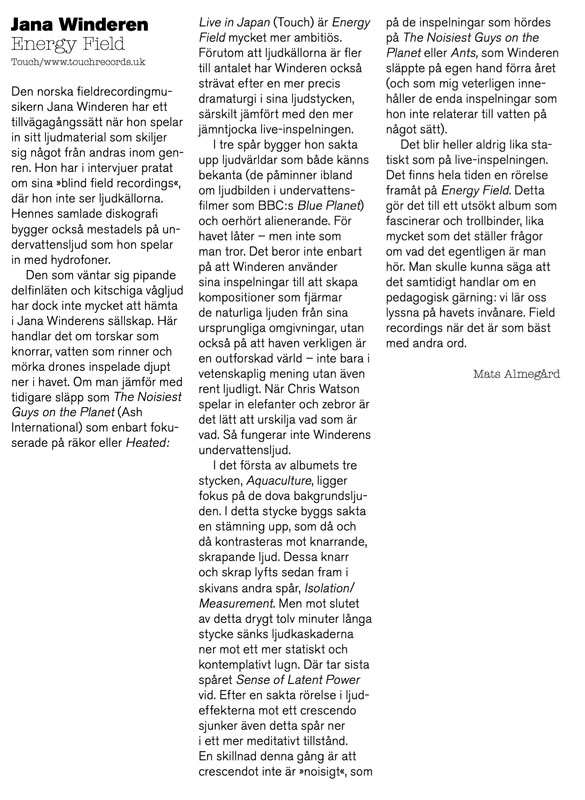
GMD (France):
Comment réaliser un dossier sur l’avant-garde sans évoquer la machine inébranlable qu’est Touch? Véritable maison-mère de la science-fiction électronique, le label Anglais (et sa succursale Ash International) y va chaque mois de ses sorties indispensables. On aura droit cette fois à un inconnu qui impressionne et à un pilier qui déçoit quelque peu. Commençons par la mauvaise nouvelle. Jana Winderen est connue pour déflorer à tout va le field recording sous-marin, à enregistrer et à agencer de manière musicale le « microcosme » maritime. Aux frontières de la biologie, de l’ambient et de l’électro-acoustique, la Norvégienne a pris pour habitude de livrer des disques uniques en leur genre (en témoigne l’excellent Heated). Mais il faut bien le dire, Energy Field déçoit quelque peu. On a droit une fois de plus à des oscillations acoustiques (entrechoquements de masses glaciaires, vie animale en mouvement, terreur des bas-fonds) d’une précision et d’un réalisme défiant le Capitaine Cousteau lui-même. Mais l’ensemble impressionne plus qu’il ne touche. Plus d’impression de vide infini. Plus de sentiments obscurs. La mathématique appliquée a pris le pas sur l’instinct, et Jana Winderen n’en sort pas gagnante (si on exclut le fait qu’elle la plus talentueuse de sa catégorie).
Neural (Italy):

OM (Spain):
blog (France):
Jana Winderen a toujours eu une fascination pour les océans. Ils sont pour elle des champs d’énergies dont nous ne savons encore que peu de choses. Elle les parcourt pour enregistrer leurs bruits, pour en capter l’intimité, en entrapercevoir les secrets.
Elle se passionne pour la capture des sons cachés, généralement inaccessibles au commun des mortels. En ce sens elle est une passeuse, elle nous révèle ce qui est habituellement inaudible comme par exemple ce qui se passe à 25m sous un glacier, dans le lit d’une rivière, dans un nid de fourmis, le son des vers, d’une chenille qui mange une feuille, de morues qui communiquent entre elles, ou d’un escargot de mer qui rampe sur un rocher.
Cependant comme le souligne très bien Tobias Fischer dans une interview qu’il a réalisé de Jana Winderen, elle n’est pas une scientifique mais une conteuse. Son dernier album Energy Field n’est pas une étude ou un traité scientifique mais un voyage dans les eaux de la mer de Barents d’où proviennent tous les enregistrements utilisés sur l’album.
Et quel voyage mes amis ! Energy Field semble reprendre les choses là où Heated les avait laissées : sur le bruit du vent arctique. Cependant d’emblée Jana Winderen veut peupler de créatures ce monde sonore quelle avait laissé vide dans son disque précédent. Des cris d’oiseaux et des jappements de chiens se font entendre. Bien vite, en revanche, les drones profonds captés au cœur des glaciers et des océans font leur apparition. Je peine toujours à réaliser qu’ils sont d’origine naturelle et non l’œuvre d’un magicien des sons. Je reste une nouvelle fois ébahi d’autant plus qu’ils sont restitués ici avec une plus grande pureté et netteté que sur Heated.
Energy Field a été conçu en studio contrairement à Heated qui était un live. Les trois morceaux qui composent l’album bénéficient donc d’une plus grande précision dans leur construction. Jana Winderen fait preuve d’une meilleure gestion des plans, et apporte aux trois compositions une plus grande profondeur de champs. Les sources sonores se complètent à merveille et le son pur et cristallin restitue et transmet parfaitement la limpidité et le froid des eaux de la mer de Barents. Les longs drones abyssaux et claustrophobiques ne sonnent plus restreints comme sur Heated, mais vastes, amples à l’échelle des étendues d’eau qui les ont générés tandis que la multitude de craquements et de mico évènements sonores ressort avec une plus grande netteté.
Le discours, le fil directeur des compositions est plus fluide également. Les progressions et les articulations sont mieux gérées. On se trouve devant une narration abstraite et ouverte mais suffisamment forte pour nous embarquer dans une rêverie arctique sans jamais nous perdre en route ni nous laisser sur notre faim. C’est un monde infini de détails qui s’offre à nous et Jana Winderen est notre guide.
Energy Field est le disque que j’attendais depuis longtemps. Une symphonie magistrale à la beauté glaciale et lourde de menace comme le paysage qui a donné naissance aux sons qui la constituent. [Johan Colin]
Drome (Italy):
Indiepoprock (France):
C’est donc dans les profondeurs marines de la mer de Barents que la Norvégienne a puisé ses échantillons. Même si l’on peut entendre dès les premières minutes du disque des cris d’oiseaux, des jappements de chiens et autres créatures peuplant la surface terrestre, elle immerge très rapidement son auditeur dans des drones collectés au cœur même des océans. Rendre l’invisible audible, voilà le projet ambitieux de Jana Winderen qui use de micros et d’hydrophones sophistiqués pour capter le plus fidèlement possible son environnement.
Il paraît tout à fait compréhensible ceci dit que ce genre de musique fondé principalement sur l’utilisation de field recordings est sujet à un évident problème de catégorisation : l’auditeur inexpérimenté pour peu qu’il ne prête guère attention à ce qu’il écoute sera tenté d’affirmer qu’il s’agit plus d’un environnement sonore que de musique. Et c’est pourtant bien là tout le talent de Jana Winderen qui ne fait pas que restituer ses sons. Elle déploie tout son savoir-faire pour livrer un véritable projet artistique et musical qui trouve sa pleine cohérence dans la juste manipulation des sons. L’écoute d’Isolation Measurement et la polyrythmie qui se dégage des craquements de glacier devraient suffire à quiconque pense le contraire. Sans oublier les dernières minutes de Sense Of Latent Power qui révèlent un profil mélodique intéressant qui tend à se dessiner à travers des sons de cabillauds.
C’est donc un véritable périple marin que nous propose dans ce disque Jana Winderen qui montre de façon plus réussie que sur son précédent disque Heated sa capacité à jouer avec les sons pour rendre compte d’une véritable cartographie sonore.










